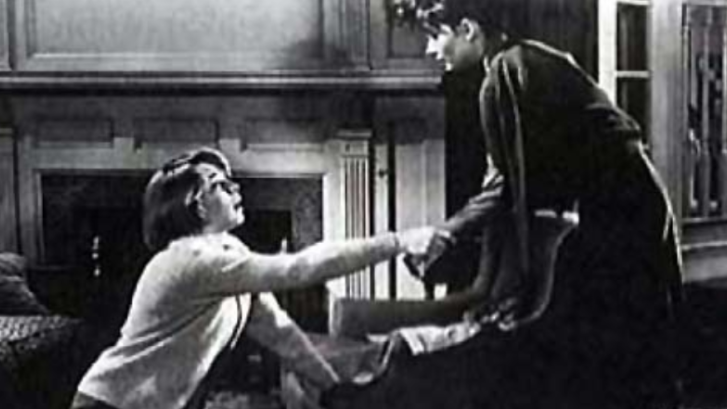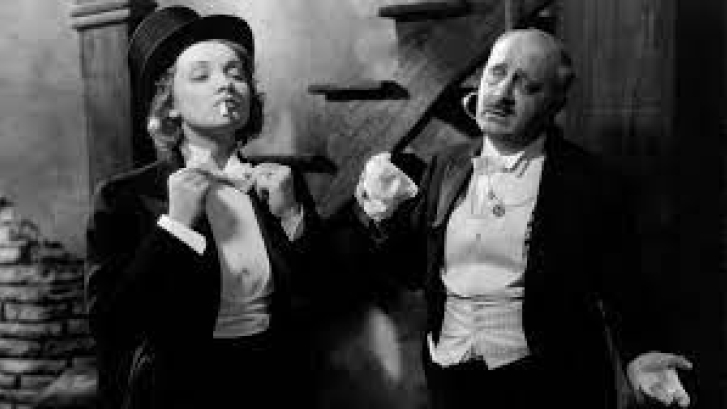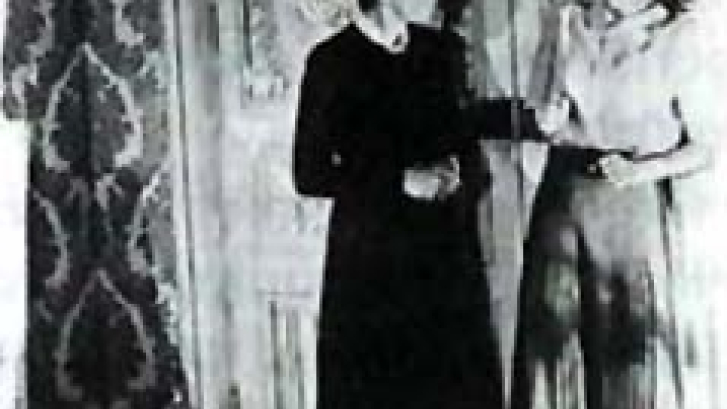The Celluloid Closet

THE CELLULOID CLOSET is both a history of lesbian and gay images, a study of how Hollywood has shaped our views of masculinity and femininity and a feast for cinéphiles everywhere. Beginning at the birth of film and examining how filmmakers and actors have put gays on the screen to the present day, the film builds up a kaleidoscopic portrait from an early Edison clip of two men dancing together right through to PHILADELPHIA and the recent New Queer Cinema. What is remarkable about the film is the line up of writers, producers, directors and actors that Epstein and Friedman have assembled - Tom Hanks, Shirley MacLaine, Susan Sarandon, Gore Vidal, Armistead Maupin, Arthur Laurents amongst others. Each one candidly speaks about their experiences - from Vidal's hilarious recounting of the 1959 BEN HUR, to serious discussion of the restrictions imposed upon them by the Hollywood powers that be. Thought provoking and fascinating, this is essential viewing for film buffs of all persuasions.
Tim Highsted, in: London Film Festival Catalogue, 1996
About the film
In Oscar-winning films such as THE TIMES OF HARVEY MILK and COMMON THREADS: STORIES FROM THE QUILT, documakers Rob Epstein and Jeffrey Friedman have been instrumental in presenting gay-related issues to a wider audience. Looking at depictions of homosexuality in mainstream American movies in THE CELLULOID CLOSET, they offer an immensely entertaining, galloping reflection on screen perceptions of lesbians and gay men, from the humorous to the heinous to the heartening. With attentive handling, this precision-tooled assembly of impeccably chosen clips and illuminating, often incisively witty interviews stands to bust out of niche markets into significantly broader commercial territory. Some gay and lesbain audiences expecting a rabid tirade against Hollywood stereotyping and misrepresentation may find the film to be less confrontational than they would have hoped. But Epstein and Friedman clearly are more concerned with objectively chronicling their subject than passionately crusading against it, and ultimately the film should benefit wholeheartedly from this in terms of its international profile on big and small screens.
The basis for the film is Vito Russo's landmark 1981 book of the same name, which analyzes how homosexuality has been portrayed on screen since the beginning of the movies and the ways in which those portrayals overlapped with or mirrored society's views. The docu throws out a swift, certain hook with a delightful title sequence of memorable gay and lesbian screen moments of both the intended and the unintended kinds. Narrator Lily Tomlin's intro then points out that in 100 years of movies, homosexuality has been only rarely acknowledged, mostly as something to get laughs, orinspire fear or pity, conditioning straight people's idesS about gay people and gay people's ideas about themselves. Hollywood's first gay stock character to come under the microscope is the effeminate sissy. Mincing fops, often treated as nature's mistakes, appeared from the century's earliest decades, demonstrating that certain stereotypes already were firmly in place virtually from the birth of American movies.
As interviewee Quentin Crisp points out, while sissy characters often flirted with transvestism, this invariably was played for laughs, but women in male drag were another matter. High on the list of lesbian icons are Marlene Dietrich in a man's suit in MOROCCO and Greta Garbo as Swedish bachelor girl monarch QUEEN CHRISTINA. During the moral crackdown of the 1920's, censors set about removing any obvious homosexual elements from the movies, but traces often remained. The Hays Code's division of films into acceptable, morally objectionable and condemned categories meant most gay themes the dust, often being translated into more palatable plol devices. Screen homosexuals then entered a new phase, becoming evil, predatory villains.
Moving into the 1950's, the docu heralds the arrival of tough lesbians behind bars and the sleek socialite model, like Lauren Bacall in YOUNG MAN WITH A HORN, interpreted by sceenwriter Jay Presson Allen as a warning for ladies to get back to the kitchen. Gay male characters became miserable or doomed, like Tom Lee's role in TEA AND SYMPATHY and Sal Mineo's in REBEL WITHOUT A CAUSE. Man-to-man affinities come under scrutiny in films like SPARTACUS, with Tony Curtis wryly commenting on his deleted hot-tub scene with Laurence Olivier. Humor consistently is worked in, playing side by side with the acknowledgement of Hollywood's stigmatizing of homosexuality. This is thoughtfully examined in regard to THE CHILDREN'S HOUR, ADVISE AND CONSENT and other films that undoubtedly impeded many gay audience members from accepting their sexuality. As the film moves systematically through each decade and trend, it shows gay visibility metamorphosing and growing, with new voices emerging to break down stereotypes and allow for more realistic representation.
Almost as stimulating as Friedman and co-editor Arnold Glassman's fluidly assembled barrage of clips are the interviews, with especially notable contributions coming from Vidal, Harvey Fierstein, Tom Hanks, Susan Sarandon and novelist Armistead Maupin, who wrote the narration. One key point that surfaces is that there will be real progress in gay and lesbian screen portrayals only when such characters are accepted at face value, and not because they are presented in non-threatening terms designed to parallel heterosexual experience. Audiences also should find food for thought in a rapid-fire montage from recent films underlining how mainstream movie dialogue still provides a continuous diet of anti-gay insults, where racial or religious slurs would be frowned upon.
David Rooney, in: Variety, New York, September 11th- 17th, 1995
(...) Interestingly, the documentary works on a couple of different levels at once. There is no doubt where Epstein and Friedman (not to mention the various Hollywood liberal notables whose interviews are sprinkled throughout) are coming from. As far as they're concerned, this is a film about the oppression, persecution, and silencing of gay and lesbian sexuality. The theme couldn't be simpler: gays and lesbians good, homophobia bad. If that were all that was going on here, the film would be one obvious, self-righteous bore.
However, there are other much more interesting and original stories being told in THE CELLULOID CLOSET. For one thing, the forcing of gay and lesbian sexuality into the closet in the early part of the century, combined with the inevitable and significant presence of gays and lesbians in the business, meant that gays and lesbians didn't disappear completely; it's just that they were forced to lead a sneaky, subversive, subliminal existence on screen, just as in real life. This explains the element which seemed to appeal most to the audience at the screening I attended: historic film clips that work on two levels, as the whitebread America of the 30's, 40's and 50's saw one thing on screen, gay screenwriters and actors hammed it up for their own amusement. Today's audience, helped along by Lily Tomlin's narration, gets to be in on all the in-jokes. Probably the biggest howler of all here is the story told by Gore Vidal, screenwriter on Ben Hur. Apparently, Vidal thought that the story needed a bit of spicing up, so he and the male actor playing opposite legendary homophobe Charlton Heston decided to insert their own little private 'subplot': the two charioteers actually had a previous homosexual romance. The only thing is, they don't bother to tell Heston about their little impromptu rewrite. The ensuing clips, with Heston obliviously playing straight while his counterpart looks soulfully into Chuck's eyes, are worth the price of admission alone.
Don Collie, in: The Campus Times, October 11th, 1995
Rob Epstein and Jeffrey Friedman about Vito Russo
THE CELLULOID CLOSET is based on the work of our late friend Vito Russo. Vito loved the movies. He was also a pioneering gay activist. He synthesized these two concerns in his study of homosexuality in the movies. Vito showed us that, by looking at how the most popular art-form of our century has portrayed homosexual characters on the screen, we can learn a lot about what society thinks about gay people - as well as what constitutes acceptable 'masculine' and 'feminine' behaviour. As filmmakers, as gay men, and as movie-lovers, we were excited by the prospect of distilling a century of images about homosexuality and presenting them in a new way. In the process, we were continually amazed by the images we found, and fascinated by the stories that emerged in the interviews about how these images came to be. The centennial of the motion picture, a time when more and more lesbian and gay characters seem to be proliferating on the screen, seems an ideal time to stand back and take stock of how we got there.
Gene Siskel and Roger Ebert from 'Siskel&Ebert' discussed THE CELLULOID CLOSET in their show on October 14th, 1995
Roger:THE CELLULOID CLOSET is not an angry or a particularly political film; it's more of a movie-lover's trip through a chapter of film history that until recently has been invisible or ignored.
Gene:I think it's a better film maybe, than you think. I think it's an important picture, and I think there is some anger in the picture, particularly in the last section of the film, when it deals with portrayals of gays labellecP as gays from the '70s through today. And that is that they're hateful portrayals, basically. It is only in just the last couple of years that we're getting anything that is approaching humanism in the portraits of gays. The picture also, I think, is significant in another way: it shows how you can take footage from films and put together a piece of cultural history that is absolutely fascinating. You could now..., I think other groups can take a look at this picture, and say 'We can tell our story, too, through the movies, through the clips.' It's terrific.
details
-
Runtime
102 min -
Country
United States -
Year of Presentation
1996 -
Year of Production
1995 -
Director
Rob (Robert) Epstein, Jeffrey Friedman -
Cast
Lily Tomlin, Tom Hanks, Shirley MacLaine, Susan Sarandon, Whoopi Goldberg, Tony Curtis, Gore Vidal, John Schlesinger, Harvey Fierstein -
Production Company
Telling Pictures Production -
Berlinale Section
Forum -
Berlinale Category
Documentary Film -
Teddy Award Winner
Best Documentary/ Essay Film
pictures from the movie
Biography Rob (Robert) Epstein
Rob Epstein was born on April 6, 1955 in New Brunswick, New Jersey. The documentary filmmaker became known to a wider audience with his film The Times of Harvey Milk (1985), which encapsulates a crucial turning point in gay politics. Since collaborating on Word is Out, Epstein has produced and directed numerous non-fiction works for national television. He has taught in the graduate program at Tisch School of the Arts at New York University, and is currently co-chair of the Media Arts Department at California College of the Arts, where he is a professor
Filmography Rob (Robert) Epstein
1986 The AIDS Show | 2002 Crime & Punishment (TV-Serie) | 2006 Ten Days that unexpectedly Changed America: Gold Rush (TV-Dokumentation) | 2013 Linda Lovelace - Pornostar | 2014 The Oscars (TV Movie Dokumentation) | 2018 Endspiel (Kurzdokumentation) | 2019 State of Pride (Dokumentation) | 2019 Linda Ronstadt: The Sound of My Voice (Dokumentation)
Biography Jeffrey Friedman
Jeffrey Friedman: born in 1951 in Los Angeles. Has worked as assistant editor on documentaries and features since 1972, including Martin Scorsese’s RAGING BULL (1979).
Filmography Jeffrey Friedman
2011 Entry Denied (Kurzdokumentation) | 2013 The Battle of Amfar (Kurzdokumentation) | 2014 Die Oscars (TV Movie Dokumentation) | 2016 Killing the Colorado (TV Movie Dokumentation) | 2018 Endspiel (Kurzdokumentation) | 2019 State of Pride (Dokumentation) | 2019 Linda Ronstadt: The Sound of My Voice (Dokumentation)

